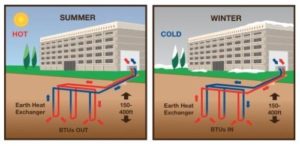In my recent article about the benefits of Oil vs. Gas for heating, it was pointed out to me that I’d left out a discussion about Ground Source Heat Pumps (commonly referred to as geothermal HVAC). I’m sure there were other things I left out as well, but the question got me thinking about geothermal and Ground Source Heat Pumps, especially because although I was aware of them, I really didn’t know all that much about them.
 So, in my usual Socratic way, I started asking questions. And then I started Googling. First, I found that although I (and pretty much everyone else on the planet) have been referring to Ground Source Heat Pumps as geothermal heat, it is technically incorrect. Geothermal heat refers to the use of heat from things like hot springs, geysers, volcanic hot spots, etc. This option is not available to everyone, obviously. Though I would appreciate a nice hot spring in my backyard, having a geyser or volcanic hot spot (whatever that is) sounds much less appealing.
So, in my usual Socratic way, I started asking questions. And then I started Googling. First, I found that although I (and pretty much everyone else on the planet) have been referring to Ground Source Heat Pumps as geothermal heat, it is technically incorrect. Geothermal heat refers to the use of heat from things like hot springs, geysers, volcanic hot spots, etc. This option is not available to everyone, obviously. Though I would appreciate a nice hot spring in my backyard, having a geyser or volcanic hot spot (whatever that is) sounds much less appealing.
The most common form of using the earth for heating and cooling is the Ground Source Heat Pump. It’s no wonder that we all short-cut this to geothermal because “Ground Source Heat Pump” is a mouthful! To save my typing fingers, I’m going to use “Geo Heat Pump” or “GeoHP” for the purposes of this blog. You may not want to use them because although they’re catchy, descriptive and best of all, shorter, I also completely made them up!
 Before I get into Geo Heat Pumps, let me back up a bit. The coolest thing about a heat pump (whether it is Ground, Air or Water Sourced) is that it is basically a two-way air conditioner. Air conditioning units work by removing heat from inside a space and putting it “outside” or somewhere else where the heat doesn’t bother anyone. The evaporator (inside unit) absorbs the heat, and the condenser (outside unit) gets rid of it. A heat pump uses reversing valves to actually reverse the process, making the condenser able to absorb heat and evaporator able to give off heat inside so that it can heat OR cool a space. Pretty great right? A traditional rooftop unit or split AC unit can’t do that.
Before I get into Geo Heat Pumps, let me back up a bit. The coolest thing about a heat pump (whether it is Ground, Air or Water Sourced) is that it is basically a two-way air conditioner. Air conditioning units work by removing heat from inside a space and putting it “outside” or somewhere else where the heat doesn’t bother anyone. The evaporator (inside unit) absorbs the heat, and the condenser (outside unit) gets rid of it. A heat pump uses reversing valves to actually reverse the process, making the condenser able to absorb heat and evaporator able to give off heat inside so that it can heat OR cool a space. Pretty great right? A traditional rooftop unit or split AC unit can’t do that.
So back to GeoHPs… When you were a kid, do you remember digging into the sand at the beach to find that once you got past the scorching hot top layer of sand, it was surprisingly cool underneath? The GeoHP works with a similar concept. It uses the earth as its “condenser” to get rid of heat into the cooler ground in the summer and reverses the process to absorb heat from the warmer ground in the winter. In the middle of summer when the air is 90-plus, deep in the earth, the temperature could be as cool as 58 degrees. So the GeoHP takes the heat from inside and brings it down into the earth to get rid of it by transferring it to the earth. The reverse happens in the winter when the air is cold, but the ground stays warm.
Here’s where things get sticky for me. It seems to me that the earth’s temperature varies depending on a number of factors including where you are in the world. Equator regions would, I assume, have much hotter earth than the North Pole, and good luck putting a GeoHP down in the permafrost of Antarctica. Even without these obvious extremes, there must be regions where these GeoHPs work better than others. Maybe some areas that are great for cooling, but total crap for heat, or vice versa. The upfront costs to these systems are huge, though I understand there are big incentives available to offset the upfront cost. But even if the system was FREE, if it doesn’t get the job done, it’s not beneficial. Some great points were raised in this article and in the comments following it that question whether Ground Source Heat Pumps are right for everyone. It’s a great question and I honestly don’t know the answer.
So help me out Geothermal Contractors…How much research is done upfront to determine the efficacy of a Ground Source Heat Pump system before installation? Are there iffy areas? What method do you use to determine which sites will work best? Do you stick a thermometer into the earth? Inquiring minds want to know…
